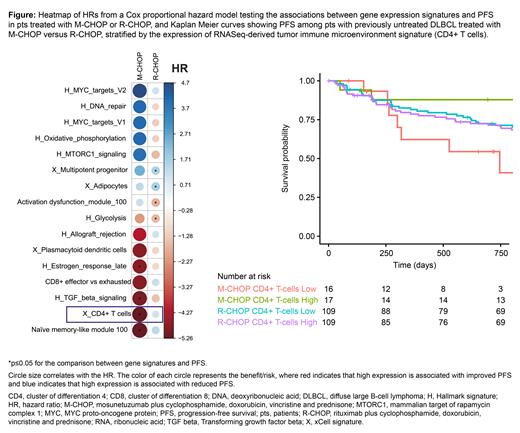Co-lead authors: Habib Hamidi and Patrick Kimes
Background: Standard induction therapy cures ~60% of patients (pts) with DLBCL; however, most remaining non-responders die from lymphoma, highlighting a need for improved first-line treatments. Biomarkers that can reliably assess the efficacy of new treatments are lacking in clinical practice. Mosunetuzumab (Mosun) is a CD20xCD3 T cell engaging bispecific antibody that redirects T cells to eliminate malignant B cells. In a Phase Ib/II trial (NCT03677141), Mosun combined with CHOP chemotherapy (M-CHOP) induced high response rates in pts with 1L DLBCL (ORR 87.5%, CR 85%; Phillips et al. ASH 2020). Here, we sought to identify biomarkers associated with M-CHOP response.
Methods: Pts with 1L DLBCL receiving M-CHOP (six cycles) in NCT03677141 and with available biomarker data were included. Bulk RNASeq data from pre-treatment tumor biopsies were analyzed using gene set variation for tumor intrinsic pathways and xCell cell-type enrichment for immune and stromal cell types. High or low expression of each gene signature was determined by median cut-off. Cox regression examined associations between gene signatures and PFS. To assess specificity to M-CHOP, gene signatures were examined in pre-treatment biopsies from pts treated with rituximab + CHOP chemotherapy (R-CHOP) in GOYA (NCT01287741; Sehn et al. J Hematol Oncol 2020). Peripheral blood biomarkers were evaluated by whole blood flow cytometry and plasma cytokines by ELISA. Circulating tumor (ct) DNA levels were measured at baseline and on treatment using the AVENIO NHL CAPP-Seq assay (Stokowski et al. ASH 2022).
Results: In M-CHOP-treated pts (n=33), gene expression analysis revealed two types of signatures associated with PFS: tumor immune microenvironment signature (TIMS) and tumor intrinsic proliferation signature (TIPS; Figure). High TIMS expression (e.g., CD4+ T cells) was associated with significantly longer PFS than low expression. Conversely, pts with high TIPS expression (e.g., MYC targets, DNA repair) had shorter PFS than those with low expression. These biological associations were specific to M-CHOP and were not observed in R-CHOP-treated pts. Consistent with the tumor-gene expression analysis, immune profiling of peripheral blood suggested that in pts treated with M-CHOP, a higher T cell baseline count was associated with a trend for prolonged PFS compared with pts with a lower baseline count. A higher count of circulating suppressive T cells was also associated with shortened PFS.
Early on-treatment pharmacodynamic (PD) changes were observed following the first Mosun dose, including: induction of TNFα and IL-6, transient margination of CD4+ and CD8+ T cells, and activation of CD4+ and CD8+ T cells. The magnitude of the PD effects were similar to observations with Mosun monotherapy in pts with relapsed or refractory DLBCL (Hernandez et al. ASH 2019), confirming that Mosun maintains its immune activation effect when combined with CHOP in pts with 1L DLBCL.
High baseline ctDNA levels were associated with high IPI score (n=32, Wilcoxon rank-sum p=0.007), ABC/non-GCB DLBCL subtype (n=30, p=0.033), and high lactate dehydrogenase (n=32, p=0.004). Pts with baseline ctDNA levels < median had a modest trend for improved PFS compared with pts > median (unadjusted hazard ratio [HR]=0.57 [95% CI 0.16, 1.75]; IPI-adjusted HR=0.72 [95% CI 0.16, 3.20]). The proportion of pts with undetectable ctDNA increased with each M-CHOP cycle (C) (C2 day [D]1, 25% [8/32]; C3D1, 69% [20/29]; C5D1, 88% [22/25]). Pts with undetectable ctDNA at any on-treatment time point (C2D1, C3D1, C5D1) had superior PFS compared with pts with detectable ctDNA (unadjusted HR=0.12 [95% CI 0.03, 0.52]; IPI adjusted HR=0.14 [95% CI 0.03, 0.61]).
Conclusions: Consistent with the Mosun mode of action, pts with high expression of TIMS and those with high levels of circulating T cells had improved PFS versus pts with low expression. In contrast, there was no association between immune cell signatures and PFS in pts treated with R-CHOP, suggesting that the different mode of action of rituximab versus Mosun may influence this. Future studies are warranted to confirm the potential clinical utility of immune cell signatures as biomarkers associated with CD20xCD3 bispecifics' activity.
OffLabel Disclosure:
Hamidi:Genentech: Current Employment, Current equity holder in publicly-traded company. Kimes:Genentech: Current Employment, Current equity holder in publicly-traded company. Schroeder:Genentech, Inc.: Current Employment; F.Hoffmann-La Roche Holding AG: Divested equity in a private or publicly-traded company in the past 24 months; F. Hoffmann-La Roche Holding AG: Current equity holder in publicly-traded company. Uzunovic:F. Hoffmann-La Roche Ltd: Current Employment. Olszewski:Leukemia & Lymphoma Society, Genetech, Inc. / F. Hoffmann-La Roche Ltd, Adaptive Biotechnologies, Precision Biosciences, Genmab: Research Funding; Genmab, Blue Cross/Blue Shield of Rhode Island, Schrodinger, ADC Therapeutics, BeiGene: Consultancy. Sit:F. Hoffmann-La Roche Ltd: Current equity holder in private company; F. Hoffmann- La Roche Ltd: Current holder of stock options in a privately-held company. Purev:Genentech, Inc.: Current Employment; F. Hoffmann-La Roche Ltd: Current equity holder in publicly-traded company. Yee:F. Hoffmann-La Roche Ltd: Current equity holder in publicly-traded company; Genentech, Inc. / F. Hoffmann-La Roche Ltd: Current Employment. McCord:Genentech, Inc.: Current Employment; F. Hoffmann La Roche Ltd: Current equity holder in publicly-traded company.
Mosunetuzumab (Lunsumio) is a bispecific CD20-directed CD3 T-cell engager indicated for the treatment of adult patients with relapsed or refractory FL after two or more lines of systemic therapy.


This feature is available to Subscribers Only
Sign In or Create an Account Close Modal